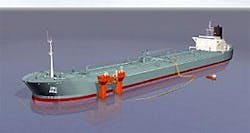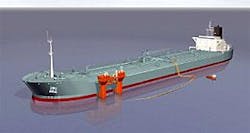NORWAY: HiLoad provides cost-effective loading system
Claes W. Olsen,Hitec Marine AS
HiLoad, a new concept for offshore loading, is particularly suitable for deepwater applications. It received third party app-roval in principal from Det Norske Veritas.
Work on the design began in 2000 when Conoco was seeking suitable offloading solutions to use with its deepwater field developments. The target was to develop a cost-effective loading system that could be used in combination with any tanker of opportunity.
Offshore storage using a ship-shape hull permanently moored on location is a common solution for field developments in most areas of the world. Due to constant wind and current directions, most FPSO and FSO units are installed using a spread mooring system. Offloading is normally done by use of a catenary anchor leg mooring buoy 2 km away or tandem offloading from the stern.
The loading rate for such storage offloading is based on loading a 1 MMbbl tanker in 24 hours. The HiLoad, which will be able to connect onto any Oil Companies International Maritime Forum-compliant tanker, will keep the tanker within a defined operational area during the loading operation. Position keeping and disconnecting will be possible in a one-year storm condition. The site-independent HiLoad system will be easy to install and re-locate. Two parking lines will connect the HiLoad to the seabed. All HiLoad systems will be fully redundant, and no single failure will jeopardize the safe operation of the system.
The HiLoad unit
The HiLoad hull is a steel structure composed of a pontoon, two towers, and a keel. The hull's arrangement reflects the high level of redundancy in the HiLoad design. The HiLoad is symmetric around the centerline and equipped with three azimuth type thrusters of minimum 1.5 mw effect each. Even with a thruster out of operation, the HiLoad maintains 100% thrust capacity.
The HiLoad is equipped with shock-absorbing fenders on the towers and the pontoon. In addition, the pontoon is covered by friction fenders to provide a distributed load between the tanker and the HiLoad. The tower fenders will be the first point of contact between the HiLoad and the tanker during docking.
The system comprises six cells surrounded by heavy-duty seals. As the HiLoad pontoon is pressed against the tanker hull bottom, the seals compress, creating six closed compartments between the tanker and the HiLoad. An ejector system pumps out the entrapped water while air at atmospheric pressure is sucked into the compartments. The generated net vertical buoyancy presses the HiLoad toward the tanker bottom.
The turret and swivel arrangement allows the HiLoad and the connected tanker to weathervane 360°. Space has been allocated for mounting a pig receiver.
The loading hose is equipped with a standard hose-end piece at the HiLoad end, with an integrated fail-safe valve to avoid an oil spill during a quick disconnect.
The marine systems include the ballast, bilge, ventilation, and cathodic protection systems.
Under the design of the power system, any electrical room can be shut down, and the HiLoad remains 100% operational.
The integrated control system (ICS) will make it possible to operate the HiLoad unit from the operation control center (OCC) on the production and storage (P/S) unit. Safety systems will be integrated with the ICS.
The HiLoad will float close to the surface at all times. It will carry the weight of the unsupported portion of the transfer hose and umbilical. When disconnected from the tanker, the HiLoad will be kept at a draft minimizing the environmental loads on the unit.
Oil transfer line
The oil transfer line will have a lazy wave configuration with a submerged buoyancy buoy between the P/S unit and the HiLoad. This configuration will provide flexibility, allowing the HiLoad to obtain a relatively large operational area.
A classic area of concern is the fatigue life of the oil transfer line at the loading buoy end, mainly due to first order wave induced motions. The HiLoad system will almost eliminate this problem because a limited waterline area characterizes the HiLoad, giving small heave, roll, and pitch motions. The metacentric stability has also been optimized to reduce pitch and roll motion, thereby increasing the fatigue life. Another factor that will improve fatigue life is the relatively short length of the oil transfer line, reducing static and dynamic loads.
Selection of riser versus submarine hose will be based on loading rate, environmental issues, design life, and customer preference. Two umbilicals will provide a redundant power and signal transfer between the P/S unit and the HiLoad. The umbilicals are clamped onto the oil transfer line. The umbilicals are terminated at the P/S unit in junction boxes and in a swivel at the HiLoad end.
A parking system designed to withstand a 100-year environmental condition will keep the HiLoad in position between loadings. The parking line configuration will allow the HiLoad to move relatively freely within the operational sector. The lines will gradually tighten as the HiLoad approaches the operation sector limits, preventing the HiLoad from drifting too far away from or too near the P/S unit.
Editor's Note: This article was adapted from the paper "Development of a mooringless deepwater offloading system for use with tankers of opportunity," presented at Offshore West Africa Conference and Exhibition in Abuja, Nigeria, in 2002.

